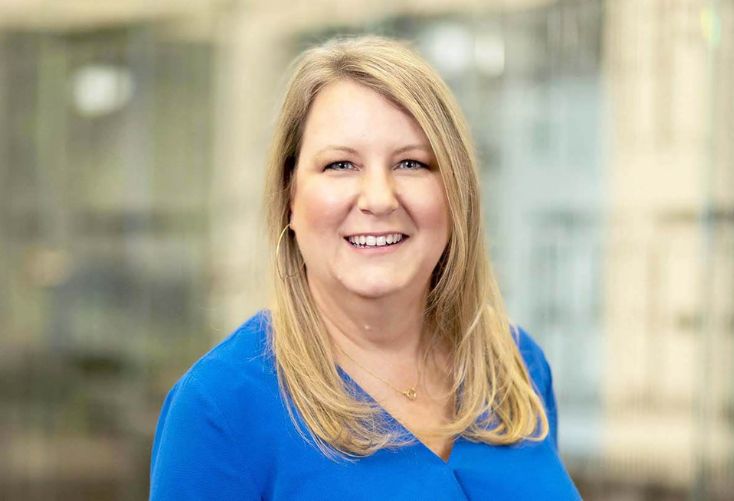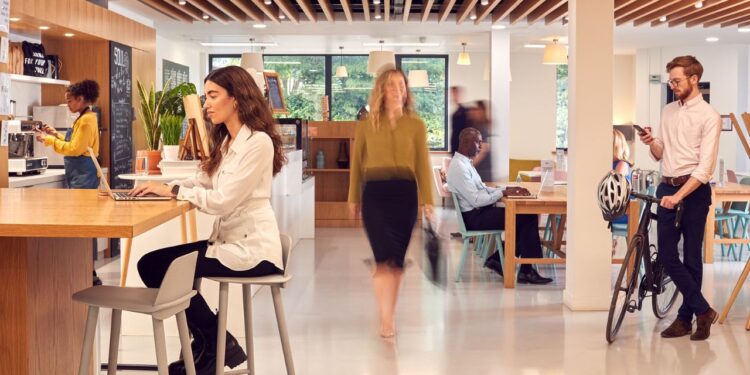- Architecture garners a lot of media attention when it comes to social and environmental impact, but what’s happening in the interior design sector?
- Expert Melissa Cooksey discusses the ways in which interior designers can take responsibility for what goes into — and comes out of — their projects.
- Cooksey shares her top resources and insights, and explains what to do if you’re experiencing pushback from your employer or client due to perceived cost.
Architects around the globe are making headlines for groundbreaking structures — from timber towers to floating parks — that tackle wide-reaching issues such as climate change and urban resuscitation. By contrast, the interior design sector can seem limited in its scope and its potential for societal impact.
But is it really lacking? And if so, what can designers do to catch up?
Melissa Cooksey, Senior Interior Project Manager at Perkins&Will’s Dallas office, wants to push the sector to break free from these perceived limitations. Allwork.Space spoke with Melissa to explore how, through interior design, workspaces can have a more meaningful impact on occupants, the environment and the communities in which they reside.

Allwork.Space: Hi Melissa! Why do you think the workspace interior design sector seems to be lagging behind other parts of the industry in terms of sustainability and social impact?
Melissa Cooksey: We tend to hear more about architecture in the media because people think it is more impactful. In reality, the interior design sector is not lagging behind but, by its nature, has to face challenges in a very different way.
The big challenge in interiors is asking where to even start, and where to focus our efforts — there are thousands of elements in interior spaces.
There is a big push in the industry to achieve a higher level of transparency when it comes to the materials and suppliers that we work with. This has taken quite a bit of demand from interior designers who want to know what products are made of, how they are sourced, and what their carbon footprint is.
“As an industry, we need to take responsibility for the materials that we bring into a building and the materials that come out of a building.”
At Perkins&Will, we are held to a level of internal review and have a thorough checks and balances process regarding the material selection and the wellness components of all our projects. One of our firmwide core values is Living Design, which is all about promoting human and ecological well-being at every level.
Allwork.Space: Why is it so important for workspace interior designers to take climate change and social impact seriously?
Melissa Cooksey: These are spaces where people will be spending much of their waking hours, so it is crucial that we provide a healthy environment. The EPA’s report on Indoor Air Quality discusses how the indoor concentrations of pollutants have increased in recent decades due in part to the increased use of synthetic building materials.
As an industry, we need to take responsibility for the materials that we bring into a building and the materials that come out of a building. It’s not just about the inhabitants of a particular structure. Building materials can also negatively impact community health if there are chemicals of concern or known carcinogens that leak into the environment.
Additionally, nearly 23% of our overall landfill waste comes from construction and demolition, so focusing on reducing any part of this is going to have a huge impact on the climate and on human health.
“Another important factor to think about is that many manufacturers across the globe are still relying on inequitable labor practices.”
The social impact of interior design can be approached in many ways. One of the first things to think about is design equity, meaning that we should be creating healthy and sustainable environments for all spaces, regardless of size of the project or the budget.
In terms of engaging with the larger community beyond the workspace, one of the biggest ways that interior designers can make an impact is by choosing to source materials locally and lift up local makers.
Another important factor to think about is that many manufacturers across the globe are still relying on inequitable labor practices. This is something that can be challenging to record and measure. The Design for Freedom Toolkit is a great resource to help design professionals source ethical and forced-labor-free materials.
We need to remember that our design choices have a much bigger reach than the occupants of one particular space.
“We can’t just look at a chair and purchase it because it fits the design aesthetic of a space.”
Allwork.Space: In the context of workspace interior design, can climate change and social issues be tackled concurrently, or should they be approached individually?
Melissa Cooksey: Climate change and social issues should absolutely be approached concurrently. We need comprehensive, holistic solutions that think about the people, the planet, and the project all at once.
Let’s look at the example of purchasing a task chair for a workplace — a seemingly simple objective. When you break it down, there are so many factors to consider beyond aesthetics: ergonomic adjustability for human comfort, where the product was manufactured and how far it will have to travel, which relates to its overall carbon footprint, whether it contains any precautionary list items that might negatively impact human health, warranties including repair and replacements, and more.
It’s all about circularity. We need to keep things out of our landfills by making them last longer. We can’t just look at a chair and purchase it because it fits the design aesthetic of a space.
Allwork.Space: What advice would you give to an interior designer who wants to create a positive social and/or environmental impact through their work, but is experiencing pushback from their employer or client?
Melissa Cooksey: To be honest, I would tell them to “just do it!”
The perception of added cost is generally the reason that clients push back on these kinds of efforts, but we have every reason to pursue social and environmental design — especially when there are so many small moves we can make that do not cost additional money.
Designers looking for guidance on making more sustainable choices have several free resources available to them, like the Parsons Healthy Materials Lab, courses through the U.S. Green Building Council, and the Carbon Leadership Forum, among others.
“…designers need to educate the client in terms that relate to them – whether that’s the ROI or their employee retention.”
One small “behind-the-scenes” move that translates into a collective big move is choosing to source samples from groups like Material Bank. Their process offsets the carbon footprint of the sampling process, and this comes at no cost to the client.
I would also advise interior designers to think critically about what they can reuse that already exists. Re-using existing materials can sometimes save both time and money, potentially requiring only light intervention or refurbishment. This choice will certainly contribute in dividends to any sustainability goals.
There are more and more companies that are coming to the market that offer reclaimed and refurbished items. Not every space needs brand-new materials. Think about things like reclaimed doors, refurbished furniture, or even scout an architectural salvage to up your level of sustainability while weaving in authenticity.
We don’t realize how many still-useful items are discarded and demolished.
In terms of “selling” sustainability and social responsibility to a client, designers need to educate the client in terms that relate to them — whether that’s the ROI or their employee retention. Discover what is important to the client and their business, and you can find a way to connect.
Deloitte’s Global 2022 GenZ and Millennial Survey is a fascinating study about how the Gen Z and millennial generations are deeply worried about the state of the world and are pressing their employers to take environmental action. The study found that only 18% of Gen Zs and 16% of millennials believe their employers are committed to fighting climate change. In the post-COVID work economy, it’s a buyers’ market.
As the owner of a workplace, why wouldn’t you want to try and retain your employees?
“If there are elements in a space no longer needed in their current state…how might we repurpose them to serve the new design?”
Similarly, WELL, a global roadmap for prioritizing health and safety, has issued a call to action to employers outlining how following WELL standards can help to attract and retain talent. With 40% of the global workforce considering leaving their employer this year, WELL argues that organizations can position themselves as a leader on issues that are top of mind for today’s job seekers, including workplace health, diversity, equity, and inclusion.
Allwork.Space: What are some of the best and most creative ways that workspace interior designers can create a positive environmental and social impact?
Melissa Cooksey: I would reiterate the importance of seeking transparency. Mindful Materials is a free database to help designers identify holistically sustainable materials. The goal is to make sourcing ethical and sustainable materials a standard for the building industry.
There are so many ways interior designers can have a positive environmental and social impact if we get creative. If there are elements in a space no longer needed in their current state, for example, how might we repurpose them to serve the new design?
Asking questions like this can inspire design solutions as unique as they are environmentally friendly.
Allwork.Space: In the absence of substantial outdoor space, how can workspace interior designers incorporate additional green space into their projects?
Melissa Cooksey: It depends on the size of the space being designed. Solutions can range from an interior courtyard to bringing in more biophilic elements such as skylights, desk plants, living walls, etc. Biophilia has been a big topic of conversation over the last few years, and we really are seeing that translate into what clients are looking for.
“Natural elements are non-gendered and potentially more inclusive of different cultures. All cultures have nature!”
They are aware of the benefits that natural elements and daylighting bring to their employees. Designers can consult resources such as the Biophilic Design Toolkit, which aims to help professionals promote connection to nature in the built environment.
Another interesting way to think about biophilia is that it can be a tool for inclusivity in design. Natural elements are non-gendered and potentially more inclusive of different cultures. All cultures have nature!
Allwork.Space: How important is it for workspace interior designers to opt for sustainable suppliers, and what even makes a supplier “sustainable” anyway?
Melissa Cooksey: It all comes down to transparency. You cannot measure what you cannot see. More and more manufacturers are offering the transparency we are seeking.
We’re also seeing increased transparency at the corporate level with corporate sustainability reports. More and more corporations are recognizing the consumer demand for a peek into their operations, manufacturing processes, etc.
“The worst mistake you can make is to take someone at their word that they are sustainable. That means nothing.”
Allwwork.Space: Finally, how can an interior designer market their “positive impact” projects without falling into the “greenwashing” trap?
Melissa Cooksey: The worst mistake you can make is to take someone at their word that they are sustainable. That means nothing.
We need to understand how and why they are sustainable. Always look for the data. This is why Perkins&Will as a firm regularly publishes white papers on our research and sustainable design processes. The proof is in the pudding!
Resources roundup:


 Dr. Gleb Tsipursky – The Office Whisperer
Dr. Gleb Tsipursky – The Office Whisperer Nirit Cohen – WorkFutures
Nirit Cohen – WorkFutures Angela Howard – Culture Expert
Angela Howard – Culture Expert Drew Jones – Design & Innovation
Drew Jones – Design & Innovation Jonathan Price – CRE & Flex Expert
Jonathan Price – CRE & Flex Expert













